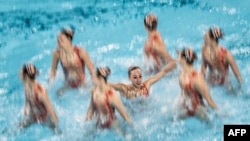China took gold in the artistic swimming team event Wednesday night at the Paris Olympics, with the United States getting silver and Spain taking bronze.
China dominated in the absence of Russia, which had won every gold medal in artistic beginning with the 2000 Sydney Games.
China finished with 996.1389 points, ahead of the Americans' 914.3421 and Spain's 900.7319. It was the first U.S. medal in the sport since 2004.
It was a big medal for China, and also a step forward for the sport, which changed its name from synchronized swimming several years ago to update its image. Some swimmers still call it “synchro.”
“There is attention to the sport that has never happened before,” said Adam Andrasko, who heads USA Artistic Swimming. “This is an absolutely different sport.”
The smiles, the makeup and hair gelatin remain, but this is no longer the water ballet beneath flowery rubber caps that your grandparents watched.
“It's so worth it, I can hardly believe it,” American Megumi Field said, her silver medal around her neck. “Now we have a silver medal. What happened. I'm so excited.”
Teammate Jacklyn Luu was quick to salute the Chinese.
“Their execution is just out of this world,” Luu said. “When you see them swim they are like machines out there. So clean. We wanted to put some of that into our swims.”
American Jamie Czarkowski also had the Chinese on her mind.
“We have a lot of respect for them," she said. “You can see how much work they put in. They deserve that gold medal — no doubt.”
Wednesday's acrobatic routines, after technical and free routines on Monday and Tuesday, put female athleticism on full display: power, endurance, and energy.
In the acrobatic routine, each team is required to include seven above-water elements. Seven times, a swimmer known as the “flier” is launched 2 meters (6 feet) above the water surface into flips, twists and dives.
She is catapulted into the air from a base of swimmers below that are not allowed to touch the bottom of the pool.
Tricks, more muscular routines and more buzz now characterize the sport, like the moonwalk routine — performed upside down with the swimmers' heads underwater — that the Americans performed Tuesday in the free routine.
Rules and judging changes adopted about 18 months ago have turned this into gymnastics on water — with a dramatic edge like figure skating. The risks are also higher.
“People are pleasantly confused about how in the world these women can do what they do,” Andrasko said.
Men had an opportunity for the first time to compete in artistic at the Olympics, but none was picked by any of the teams. There is consideration to add a mixed duet team event for Los Angeles 2028, which would create more space for men to compete.
“There was not nearly enough time for nearly enough males to prepare for this chance,” Andrasko said. “It was a challenge to step up interest in a year and a half before the Olympics.”








